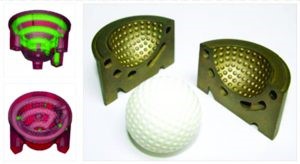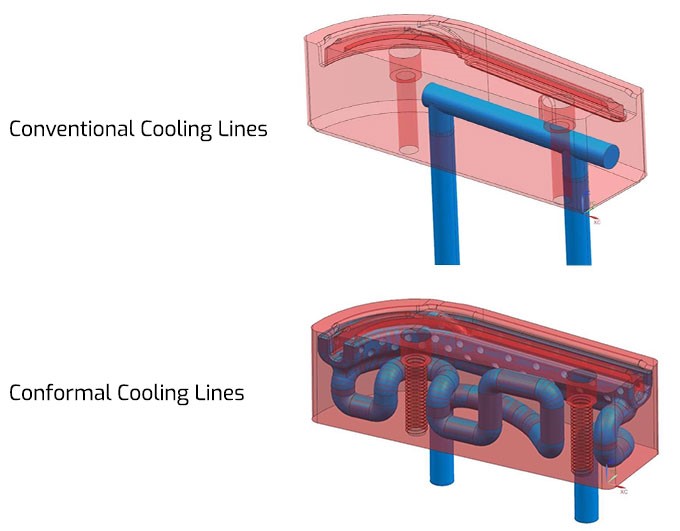
Blogs

Manufacturing processes are changing significantly as a result of 3D printing, particularly when it comes to producing intricate geometrical patterns. Complex (non-conventional) cooling solutions are becoming more and more popular in the injection molding sector as 3D printing technology advances. The process of forcing melted plastic in to a mold cavity is known as injection molding. The portion can be ejected after the plastic has cooled. Injection molding is a relatively modern method of producing parts that is frequently utilized in large production and prototyping.
To help manage part quality and cycle time, additive manufacturing techniques like Direct Metal Laser Sintering (DMLS) can almost print any complex cooling circuit design that can be imagined. Complex geometries and dimensional accuracy are the two primary requirements for a plastic injection mold. An injection mold needs to be effective enough to produce complex plastic pieces. To increase the effectiveness of injection molding, a good cooling system is crucial.
To cool the formed parts, the injection mold needs a cooling channel. Right now, there are two categories of cooling channels:
- Regardless of the shape of the object, the traditional cooling system consists of a straight cooling channel that is placed in the middle of the object.
- A Conformal Cooling Tooling is created using the interior shape of an injection molding object. Because of its increased effectiveness, manufacturers now choose this.
The traditional cooling channel's outcomes are inconsistent because it is created in straight lines. The molding chamber is not uniformly cooled by it. Additionally, the intricate geometry, curved surface, and various wall thicknesses of the plastic pieces hinder uniform cooling. This uneven cooling has a negative impact on the production process as following
- It is time-consuming
- More warpage
- More wastage
- Increases overall cost
- High rejection rate
What is Conformal Cooling?
Conformal cooling is a procedure in which the cooling tunnel conforms to the shape of the cavity and mold core to promote temperature uniformity and conduct fast uniform cooling for the injection molding process.
Plastic components with complex geometries require more time to cool. Additionally, uneven cooling is hampered by the curved surface and changing wall thickness of the plastic component, which leads to the accumulation of residual stresses that produce warpage. It is difficult to achieve uniform cooling in such intricate geometries with traditionally straight drilled channels. A range of cross-sections, including rectangular, circular, elliptical, half-circular, etc., as well as the exact cross-section of the part can be used to 3D print conformal cooling channels.
Steps in the conformal cooling process
Choosing the right part: The first step is to choose a plastic injection-molded object and assess fill time and pack time using FEA software.
Analysis: Analyze cooling duration, volumetric shrinkage, and deflection using a conventional cooling channel now.
Designing: The next stage is to design the conformal cooling channel using the information provided by the previous analysis.
Printing: In the last stage, use the conformal cooling channel to assess cooling time, volumetric shrinkage, and deflection. Compare the results and print the mold insert based on the outcomes of the analysis.
Benefits of Conformal Cooling Tooling
Using additive manufacturing for conformal cooling has a number of advantages, including better product quality, energy savings, reduced scrap, productivity, and overall efficiency. It is more efficient to use additive manufacturing for conformal cooling when the production volume is high and the pieces have intricate geometries. Excellent surface finishes, cycle time reductions (up to 70% in some cases), and significant production cost reductions can all be achieved using 3D printing.
There are many additional advantages, including the following:
- Increased part dimensional stability.
- Minimal shrinking and warpage of the pieces.
- 50 percent increase in production
- Higher-quality plastic pieces with improved surface finishes.
- 1.3–1.8 times longer tool life than with conventional tooling.
- Minimal thermal gradient while cooling the part.
- A significant decrease in part rejection.
- A reduction in the amount of labor, machinery, space, and energy needed for production.
- Shorter delivery time.


The first image shows how Conformal Cooling Design can improve the quality of injection molded tennis balls and the second image shows Conformal Cooling Channel Designs for improving Process Efficiency.
In order to accommodate the intricate product contour, cooling channels can be produced in any geometry by employing a non-traditional production technique like laser sintering. This results in a shorter cycle time and improved cooling efficiency.
Industry Applications of Conformal Cooling
The following production methods have utilized Conformal Cooling Channels made of metal and helped by 3D printing.
Plastic injection molding: An expanding field of research in plastic injection molding is the enhancement of cooling systems. The process of injection molding is cyclical in nature. The steps involved in the injection molding process are filling, packing, cooling, and ejection. The cooling stage is one of the steps involved in the injection molding of plastics and is crucial because it impacts productivity and mold quality.
Pressure Die Casting: Conformal Cooling Channel in die casting application increases surface smoothness of castings since spray cooling is not required as much, which is made possible by a faster and more even cooling rate. Reductions in cycle time and shrinkage porosity are two additional advantages.
What makes conformal cooling tooling superior to traditional cooling?
The conformal cooling technique, which helps to boost the productivity and quality of plastic parts, has greatly benefited from the use of metal 3D printing. Although additive manufacturing has the potential to increase the efficiency of injection molding, it still has space for development.
Through the custom 3d printing of conforming cooling channels with a range of cross-sections, including rectangular, circular, semi-circular, elliptical, etc., that are precisely in accordance with the molded objects, the cutting-edge additive manufacturing technology has completely eliminated these effects.

The cooling channel is shaped to match the mold course and cavity in the conformal cooling system. This ensures temperature consistency and facilitates quick cooling during injection molding.
Innovae3D is a leading manufacturing company offering on-demand 3D Printing in Pune. Innovae3D has a state-of-art Additive Manufacturing infrastructure. We provide innovative solutions for our customer's Additive Manufacturing requirements. Innovae3D provides the Best 3D Metal 3D Printing Services in India along with
- Metal 3D Printing Services in Mumbai, India
- Metal 3D Printing Services in Bangalore, India
- Metal 3D Printing Services in Delhi, India
- Conformal Cooling Tooling
- Rapid Prototyping Services in India
To know more about our services, contact us